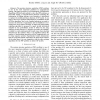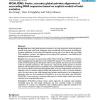439 search results - page 29 / 88 » Maximum entropy methods for biological sequence modeling |
CEC
2009
IEEE
14 years 1 months ago
2009
IEEE
— The protein structure prediction (PSP) problem is one of the most important problems in computational biology. This paper proposes a novel Estimation of Distribution Algorithms...
COLING
2008
13 years 10 months ago
2008
This paper explores the use of the homotopy method for training a semi-supervised Hidden Markov Model (HMM) used for sequence labeling. We provide a novel polynomial-time algorith...
BMCBI
2010
13 years 9 months ago
2010
Background: Flavin binding proteins (FBP) plays a critical role in several biological functions such as electron transport system (ETS). These flavoproteins contain very tightly b...
BMCBI
2011
13 years 4 months ago
2011
Background: Remote homology detection is a hard computational problem. Most approaches have trained computational models by using either full protein sequences or multiple sequenc...
BMCBI
2006
13 years 9 months ago
2006
Background: Non-coding DNA sequences comprise a very large proportion of the total genomic content of mammals, most other vertebrates, many invertebrates, and most plants. Unravel...


